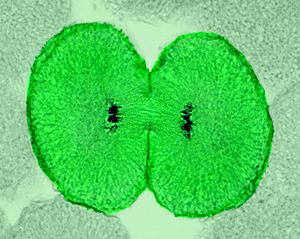| BIO372 : Biological & Ecological Implications of Sex | ||||
| BIO372 : Biological & Ecological Implications of Sex | ||||
Some of the most ubiquitous organisms in our environment, bacteria, produce offspring which are exact copies of the parent cell. They are fast - as fast as 20 minutes between generations - and efficient in producing individuals to take advantage of opportunities in the habitat.
 |
This is a photograph of one of the final stages of asexual cell division (mitosis) in the whitefish. Next, the membrane of the cell will pinch down along the equator, creating two separate cells. |
In this section, we will take a look at differences in reproductive modes: sexual versus asexual. We will examine the implications of reproductive mode for organism survival and adaptation.
In the previous section of the course, we considered an organism biologically successful if its behavior results in the survival and reproduction of other individuals possessing the same genes as it does. In this section we will see that sexual reproduction produces organisms with a mixture of genes from two parents and the process recombines the original genes in novel arrangements.
As you read the papers in the course pack, be particularly attentive to:
After completing this module, you should be able to:
To complete this module, you should:
 Copyright 2000
Northern Arizona University
Copyright 2000
Northern Arizona University